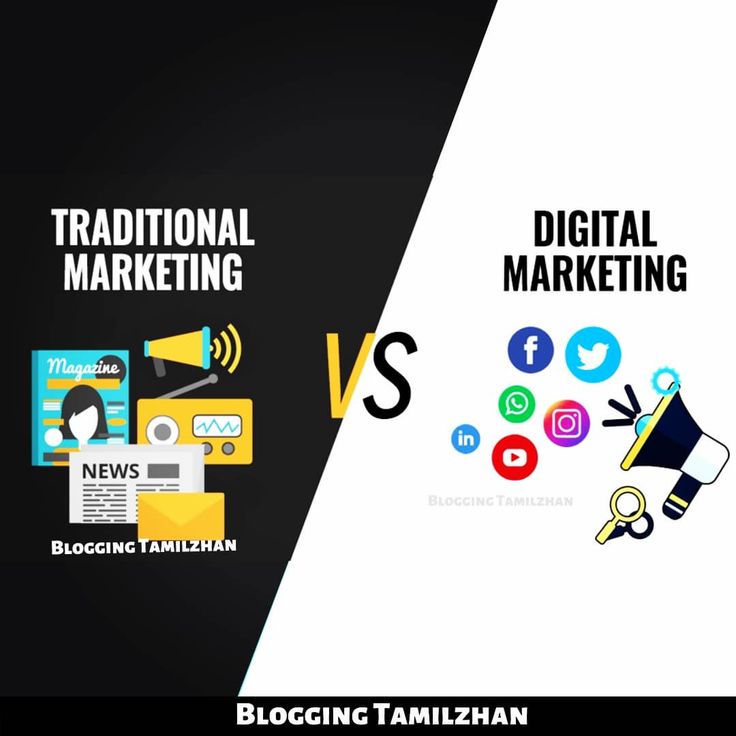
Digital Marketing
Digital Marketing is the use of digital channels, technologies, and online platforms to promote products, services, or brands to reach and engage with target audiences.
IT INVOLVES STRATEGIES AND TOOLS SUCH AS:
- Search Engine optimization (SEO): Improving website visibility on search engines.
- Social Media Marketing (SMM): Promoting through platforms like facebook, instagram, linkedin, etc
- Email Marketing: Sending targeted messages to subscribes.
- Pay-Per-Click (PPC) Advertising: Paid ads on google, social media, or websites.
- Affiliate & Influencer Marketing: Partnering with other to promote products.
- Analytics & Data Marketing: Using data insights to optimize campaigns.

Traditional Marketing
Traditional marketing is a form of marketing that uses offline channels and conventional media platform to promote products, services, or brands to consumers. it relies on physical and broadcast methods such as television, radio, newspapers, magazines , billboards, posters, direct mail, and face-to-face promotions to reach a wide audience.
IT USUALLY INVOLVES PHYSICAL AND MASS-MEDIA CHANNELS SUCH AS:
- Television ads
- Radio commercials
- Newspaper & magazine ads
- Billboards & posters
- Brochures, flyers, and pamphlets
- Events, trade shows, and sponsorships
CONCLUSION
Both digital marketing and traditional marketing play an important role in promoting products and services. Traditional marketing uses offline channels like newspapers, TV, Radio and billboards to reach a wide audience, while digital marketing relies a wide audience, while digital marketing relies on online platforms such as social media, website , and emails to connect with targeted customers.
In today world, digital marketing is more cost-effective, measurable, and interactive, whereas traditional marketing is powerful for building trust and reaching local or offline audiences. The most successful businesses often use a blend of both approaches to maximize their reach strengthen their brand and achieve better results.
Which Is Better
| Feature | Digital Marketing | Traditional Marketing |
| Cost | More cost-effective, with lower entry costs and scalable campaigns. | Can be very expensive, especially for prime placements like TV or billboards. |
| Targeting | Highly precise, allowing you to target based on demographics, interests, and online behavior. | Less precise, often casting a wider net, though it can be effective for local audiences. |
| Measurability | Highly measurable with real-time analytics to track ROI and campaign effectiveness. | Difficult to measure ROI accurately, making it hard to track the direct impact of a specific ad. |
| Flexibility | Campaigns can be quickly adjusted and optimized in real-time based on performance data. | Campaigns are less flexible and require advanced planning, making adjustments difficult or impossible once launched. |
| Audience Engagement | High levels of two-way communication, engagement, and real-time feedback through social media and other platforms. | Lacks the level of direct interaction and immediate two-way communication that digital offers. |
| Reach | Offers global reach, allowing you to connect with an audience regardless of their physical location. | Typically limited to a specific geographic area (e.g., local newspaper, regional TV). |
When To Choose Digital Marketing
- You want to trackable results and optimize ad spending
- Your target audience is active on social media and the internet.
- You need to make real-time adjustments to your campaign.
- You need to reach a global audience or a very specific niche.
When To Choose Traditional Marketing
- You need to reach a local audience or an older demographic that is less online
- You are aiming for strong brand recall and credibility through physical media like billboards or print.
- You have a large budget for a broad campaign and want a strong local presence.
Neither digital nor traditional marketing is inherently better; the “best” approach depends on the specific business, its goals, and its target audience. Digital marketing is generally superior for its cost-effectiveness, precise targeting, measurability, and real-time flexibility, especially for reaching younger and tech-savvy audiences. Traditional marketing can still be more effective for reaching local audiences or older demographics, providing strong brand recall, and building credibility.
Future Of Marketing
The future of marketing is characterized by an AI-first approach, hyper-personalization, and immersive experiences through technologies like VR and AR, alongside a growing emphasis on authentic connections via user-generated content and community-driven strategies. Marketers must focus on building trust, embracing data-driven insights, fostering sustainability, and collaborating with AI to deliver meaningful experiences and achieve greater efficiency and ROI amidst shrinking budgets.
Strategies For Success
Embrace Adaptability: The marketing landscape is dynamic, making continuous learning and adapting to new technologies and platforms essential.
Human-AI Collaboration: AI will elevate, not replace, marketers by handling repetitive tasks, freeing up human creativity for strategic planning, emotional connections, and storytelling.
Focus on Experiences: Delivering meaningful and personalized experiences will be crucial to creating lasting customer relationships and building brand loyalty.
Leverage Data Ethically: Utilize first-party data to create personalized experiences while maintaining honesty and transparency to build trust with consumers.
Integrate Digital and Physical: A cohesive strategy across all digital and physical touchpoints will be necessary to reach and engage audiences effectively.